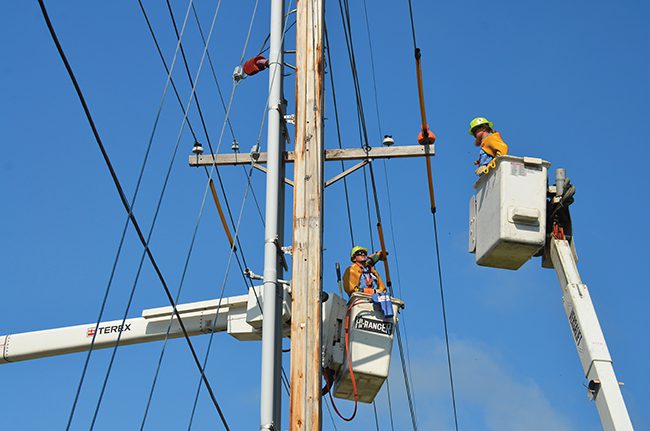How Electric Utilities' Risk Management Supports Operational Resilience Efforts and Emergency Response
Severe weather conditions have a tremendous impact on our power grid as well as downstream costs for people, property, and brands that are costly and time-consuming to recover from. For example, Entergy New Orleans deployed a workforce of nearly 27,000 people from 41 states to aid in the restoration of power in the aftermath of Hurricane Ida, a process that is still underway months later. Significant parts of the power grid were almost lost in Texas and the Southeast during the winter storm Uri in February 2021. On the West Coast, the possibility of wildfires has routinely triggered power shutoffs to reduce the threat when high winds and drought present significant risks.
 |
|
1. Wildfires have become more frequent, particularly in the U.S. West, which has experienced years of ongoing drought. Utilities in these areas have become more mindful of taking steps to mitigate the fire risk of their equipment. Courtesy: Marcus Kauffman via Juvare |
Whether it is a hurricane, wildfire (Figure 1), or a winter storm, extreme weather has frequently caused operational and system failures that have left thousands of people in uncomfortable or vulnerable conditions. Often, the impact of an extreme weather event is exacerbated by inadequate preparedness—either by planners asleep at the wheel or, more likely, an organization-wide underinvestment in maintaining situational awareness and preparedness.
These types of disruptions have had long-lasting damage on both the community and electric utility providers. Indeed, we believe that investments to improve situational awareness and preparedness will become the norm as the economic, regulatory, and reputational costs continue to increase. Forward-thinking leaders know that planning for emergencies is critical and can be established using existing emergency management principles; it is time that robust operational resilience is a priority for all commercial and governmental utility providers.
Risk Management and Operational Resilience
Simply put, operational resilience is critical for electrical utility providers because all elements of the community rely on power to live and function in their communities. Access to power becomes even more critical when disaster strikes. While power disruption can occur due to hurricanes, fires, earthquakes, storms, and other natural and man-made disasters, a risk management strategy that focuses on safety and speed to restore service (Figure 2) on a broad range of scenarios is vital. Electric utility providers with a thorough emergency plan, modern information technology infrastructure, and reliable communication channels will minimize the deleterious effects from these increasingly routine events.
 |
|
2. Utilities know the importance of organizational plans to restore power as quickly as possible after natural disasters and extreme weather events. This often means coordinating with first responders, and government agencies, to support power restoration efforts. Courtesy: American Public Power Association via Juvare |
In the case of the wildfires in the U.S. West (see sidebar), the utility sector sent mutual aid utility crews into hot zones, at times without proper coordination between their teams, emergency medical technicians (EMTs), firefighters, and municipal and state government leaders. First responders must remain aware of utilities’ infrastructure and activities in the field through access to information such as location awareness between utility crews and firefighters, the status of evacuation and right to return orders, detailed maps that show fire locations and area conditions, and whether electricity is still active in specific areas. By evaluating all associated risks and implementing an effective disaster preparedness and response solution, utility providers can better manage their operational exposure to a number of threat vectors and respond more efficiently when dangerous situations ensue.
|
Measures Taken After Wildfires The growing damage from wildfires in the U.S. West, and the expectation of increased risk of these fires due to climate change, has led utilities to take significant steps to upgrade their power systems to mitigate the impact of these events. Pacific Gas & Electric (PG&E), which filed for bankruptcy in 2019 due to the costs sustained by the utility after its equipment was found to have contributed to a series of wildfires in California, is spending billions of dollars on safety improvements. Those upgrades include a new computerized risk model to predict areas most prone to catastrophic fires. PG&E has prioritized work to replace old power equipment, trim trees, and make other changes in those areas. PG&E in plans filed with state utility regulators last year said it would install more fire detection cameras and weather stations at key lookout points across the 70,000 square miles of its territory. It is updating its power grid equipment with more resilient materials. It also began instituting public safety power shutoffs—or PSPSs—in a proactive move to reduce fire risk during periods of extreme weather, primarily high wind events. Recent wildfires that destroyed more 1,000 homes and businesses in the suburbs between Denver and Boulder, Colorado, renewed interest in Xcel Energy’s efforts in that state. The utility has a $600 million wildfire mitigation program designed to reduce the risk of fire from its electrical equipment. Xcel has said the plan includes enhanced risk analysis to identify where wildfire protection work is most needed, along with accelerated repair and replacement of equipment to enhance system protection. Xcel also has increased vegetation management in fire-prone areas. Mountain Parks Electric, an electric utility headquartered in Granby, Colorado, experienced one of the worst fires in Colorado history in October 2021 when the East Troublesome Fire burned nearly 194,000 acres in the cooperative’s service territory. The fire burned for more than a week, most dramatically during a period from Oct. 20 to Oct. 23, when it reached Rocky Mountain National Park and crossed the Continental Divide. Though authorities said they suspect the fire was human-caused, and do not think it had any connection to power grid infrastructure, Mountain Parks has spent about $1.5 million in improvements to its system. Those upgrades include underground construction of some power lines, and clearing of vegetation around power poles and transformers. The co-op also has worked with the U.S. Forest Service to deter birds from nesting atop power poles. Another improvement on the Mountain Parks system was the installation of fault interrupters, so-called “trip savers,” a device that does not spark when a fuse is blown. The device provides protection, containing the arc from a blown fuse inside the unit, so it does not create the potential of fire. —POWER staff |
How Do Electric Utility Providers Achieve Operational Resilience?
To achieve operational resilience, utility companies must routinely assess emergency preparedness and response capabilities. Doing so increases the likelihood that damage to property, facilities, and equipment is minimized, costly downtime is eliminated, and regulatory standards are being met. Incident management technology platforms make planning, response, and recovery easier for organizations. Helpful platforms are designed to adapt to an organization’s existing and future processes and are scalable for use at one site or across enterprises; exceptional platforms also allow organizations to connect with other stakeholders to selectively share data in real-time using existing networks and infrastructure.
To decide what best serves the public, electric utility companies must facilitate accessible and clear lines of communication with critical infrastructure facilities such as power plants, first responders, critical care facilities and EMTs, and government officials. Without complete visibility into daily operations and during emergencies, stakeholders are left with guesswork, slowing down decisions and impacting the community’s safety.
While risk is commonly associated with significant events, a slight change in legislation also can disarm operational resilience efforts. Failing to adapt quickly and willingly to new industry standards, or state and federal standards, can be costly in the form of fines, legal exposure due to the inability to react to conditions, or reputational damage. Incident management technology platforms that enable adaptation to regulatory changes, along with operational data, will help organizations avoid litigation, and will further operational resilience objectives.
Tasks that electric utilities should be performing to achieve and maintain operational resilience include:
■ Reporting events that impact power supply.
■ Communicating with stakeholders.
■ Drafting and routinely updating plans for emergency operations.
■ Coordinating reliability of critical infrastructure.
■ Mapping of responses to potential threats.
■ Building daily resilience.
Building Resilience
Incident management technology platforms can help electric utility companies achieve operational resilience by providing all parties with a single source of truth or a common operating picture that is used daily. However, operational resilience requires that people, process, and technology work in tandem. Resilient organizations choose and use technologies to help build muscle memory that supports an active response and recovery.
To be truly effective organizations must create a culture and processes that embrace technology to build strategic, everyday resilience. For example, if utility crews can gain the same situational awareness when natural and human-caused disasters strike as when using the software daily, they will develop the organizational muscle to initiate a swift transition into emergency management. By daily monitoring of logs and ensuring appropriate use of technology, users will know how to use their tools appropriately when the stakes are particularly high. And by routinely practicing data sharing with third-party response teams through drills and table top exercises, collaboration during times of crisis will start from a higher plane of mutual trust and understanding.
Lastly, operational resilience plans and exercises must complete the loop, planning and practicing for a successful recovery. A return to normal operations itself requires planning, reviewing the recovery, and re-evaluating the plan with new information to improve subsequent recoveries. Typical recovery plans yield lessons for people, process, and technology; resilient companies rely not only on proactive tools such as emergency management systems, but also processes and a culture that enables their people to adapt quickly when emerging threats come into view.
—Kaleb Brown is director, International Channel Partners at Juvare, a global emergency preparedness and emergency response provider based in Atlanta, Georgia.